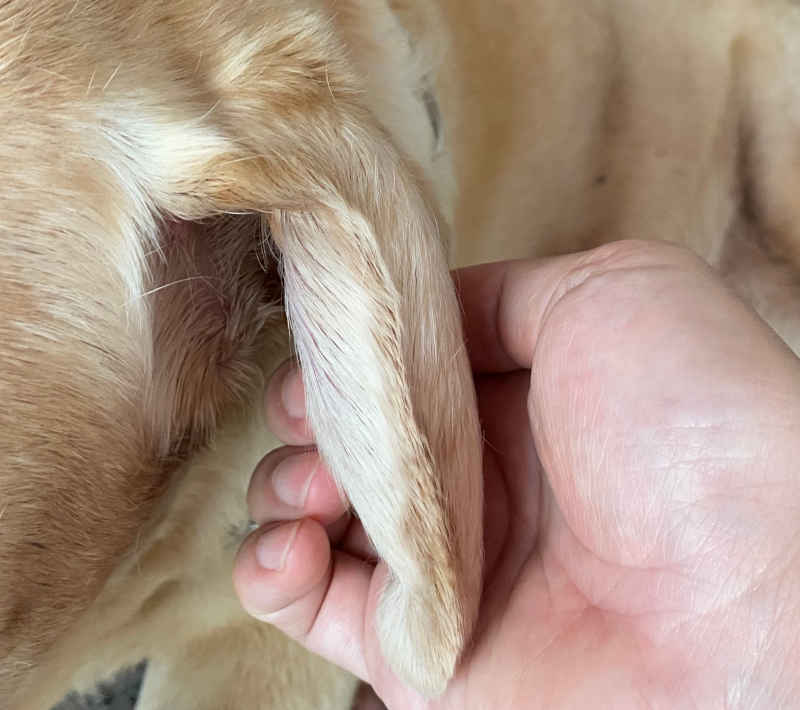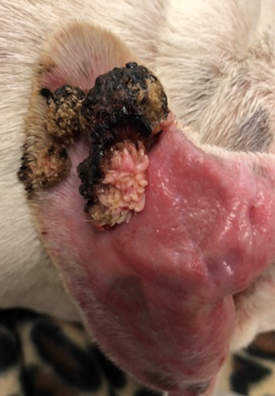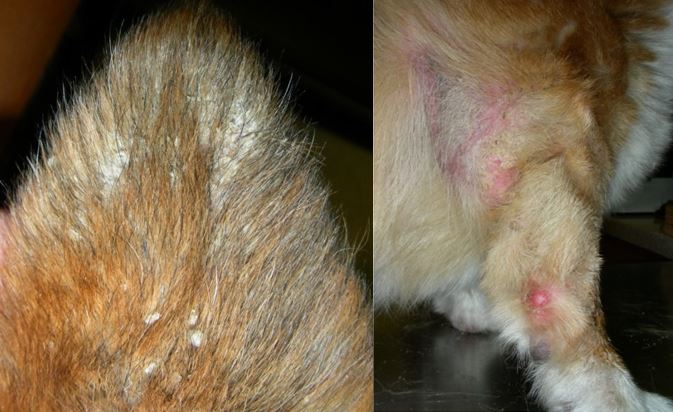
This article was updated on January 11th, 2024

As a veterinarian, I often come across various ear flap conditions, which can be quite concerning for pet owners. However, most of them can be treated effectively. In this article, I will discuss the most frequent lumps and bumps that can occur inside or outside the ear flap and provide advice on how to deal with them.
The most common issues with dog’s ear flaps
1. Ear flap hematomas
The most common ear flap condition in dogs is a hematoma. Hematomas are characterized by a swelling that may involve the entire ear flap or just a portion of it. It will feel as though the ear flap is very thickened, and it may feel a little bit like a water balloon.


Sometimes, the ear flap can be quite hot and painful, and the dog may shake and scratch at their ears, too.
Learn more about ear flap hematomas.
2. Histiocytomas
Young dogs may develop histiocytomas on their ear flaps. Histiocytomas are rapidly developing, raised, often reddish lumps. They can be quite alarming because they can develop almost overnight. Below is a picture of a histiocytoma on a dog’s ear flap:

Histiocytomas appear as single, dome-shaped growths, and typically don’t cause any pain, itching, or irritation. It can be hard to tell them apart from cancerous tumors, but histiocytomas are mostly benign. Learn more: Histiocytomas: Pictures & Vet Advice.
3. Papillomas (warts)
Papillomas are often whitish in color. They can show up as a single small lump, or as a group or cluster of tiny lumps which look a little bit like a cauliflower floret. Below are two pictures showing large warts on a dog’s ear flap:


Warts on dogs can appear in various colors, including pink, black, brown, or the same color as the surrounding skin. They are mostly benign and usually don’t need any treatment unless they get infected, get in the way, or become irritated.
Warts are caused by a virus and can often be crushed under light sedation to release some of the viruses into the bloodstream, and then the dog’s own immune system will mount a response against the virus, and the papillomas will resolve. If they occur in older animals then the vet will need to do further tests to make sure that the animal doesn’t have an underlying condition that is suppressing their immune system. If the papillomas are extensive, then the dog may need anti-viral medication.
View more Pictures of Warts.
4. Cysts on the ear flap
A cyst is a liquid-filled swelling that develops in the skin. They are formed when either the sweat glands or the sebaceous glands in the skin become blocked, and then fluid builds up in the gland or if the ear flap has been injured in some way.

They can vary in size from a few millimeters to about an inch in size. They are generally not painful, and they can sometimes ooze a liquid substance.
Cysts and tumors can look very similar. Thus, it is essential to have any bump on your dog’s ear flap checked by a vet to determine exactly what it is. If the lump is a cyst, then it can sometimes be drained quite easily with a needle, or it can be left and monitored. If it is causing the patient discomfort or has become infected, then the vet may recommend removing the cyst completely.
Learn more about Cysts in Dogs. Cyst on ear flaps.
5. Abscesses
Ear flap abscesses can look very similar to aural hematomas. Often, there is a thickening of the ear flap – either just a portion or the entire ear flap. The ear flap will be hot, red, and very sensitive or painful to the touch. An abscess is an area of infection, and this may result in your pet being unwell. They may be feverish or refuse to eat their food.
What causes ear flap abscesses? They are generally caused by trauma. Most cases that I have seen have been as a result of a dog or cat bite or an injury by a sharp object (e.g. a thorn). This trauma will often cause a small wound on the ear flap, and if left untreated, the entire ear flap can become infected and form an abscess.
Are these abscesses dangerous? If left untreated, abscesses can spread infection to the rest of the body, resulting in septicemia, and this can be life-threatening for the dog. They are also extremely painful.
Tests and treatments: The vet will often take a sample using a needle to confirm that the swelling on the ear flap is an abscess. Depending on the extent of the abscess, the dog will likely need antibiotic treatment. If they are very unwell, they may need hospitalization and more intensive treatment. Sometimes, surgery may be needed to flush the ear flap and repair any underlying trauma.
6. Tumors on the ear flap
The ear flap of a dog is made up of layers of cartilage covered in skin. Any skin tumor may affect the ear flap too. Many of these tumors may be benign but there are a few types of tumors that may be malignant.
“Due to the location of the dog’s ear on the dog’s head it is critical to have any lump checked by a vet as soon as possible because it may be difficult to safely and effectively remove a tumor on the ear flap if it becomes too large.”
What do ear flap tumors look like?
Tumors will mostly start as a small, rounded, swelling on the ear flap. It may be hard or soft and located on the inside or outside of the ear flap. Sometimes, they will be the same color as the surrounding skin, but some of them may be red-pink, white, or black. They may still have a hair cover or they may lose their hair covering. If they become larger or if the dog traumatizes them in some way, they may bleed or become infected. View pictures of ear tumors.
7. Mast Cell Tumors
Mast cell tumors can also develop on the ear flaps. These tumors can vary in appearance – from a small colorless bump to a large, ulcerated, and oozing mass. They can be particularly aggressive and need to be identified and treated promptly.
Tests and treatments: The vet will generally take a small sample using a needle and analyze the sample under the microscope. This is generally a painless and quick test. This analysis will give the vet an indication of what type of growth this is and whether it is benign or malignant. Sometimes they may need to get a slightly larger sample by doing a biopsy.
The vet will take the type of tumor, dog’s age, and general health into account when deciding whether surgical removal of the tumor is an option. This may involve a small surgery if the tumor is small and in an easy-to-remove location. If the tumor affects a large portion of the ear flap then the entire ear flap may need to be removed. This is also known as an ear flap amputation, as shown in the picture below.

If the tumor is malignant, then the vet may suggest other treatments after surgery, including radiation and chemotherapy.
8. Infections
There are a variety of different infections that may cause skin issues or scabs on ears. Infections can cause extreme irritation and the dog will often try to scratch and paw at the ear to relieve the irritation.

Types of infections include:
Parasitic infections: The scabies mite (Sarcoptes scabiei) often infests the tip and edges of the ear flap, causing hair loss, reddening of the skin, and extreme itchiness. This mite is highly contagious to other animals as well as to humans.

A vet will diagnose this mite by doing a skin scraping of the affected ear and then examining the sample under the microscope. If the dog is positive for the sarcoptic mange mite, the vet will recommend a specific parasiticide (anti-parasite medication) to treat the dog. The other animals in the household may also need to be treated.
It is important to note that sarcoptic mange is highly contagious and can be passed to other animals as well as humans.
Fungal infections: dogs may develop fungal infections on the ear flap. Sometimes, these areas will be roundish and will be red, and crusty. They can be extremely itchy and irritating to the dog. Fungal infections are diagnosed by the vet by examining the ears with a UV lamp or by taking a small sample and submitting it to the laboratory for culture and further analysis. Some fungal infections are contagious to other animals and humans. In small numbers of cases, the fungal infections can spread to other parts of the body and they can be quite serious.

Treatment involves anti-fungal medication, which may be applied directly to the ear flap if the area is small. If the affected area is large, or if there are other areas in the body that are affected, then oral medication will be prescribed.
Other infections: dogs may develop other infections on the ear flap, which can result in white bumps, sores, or swellings. Infections will cause a swollen, reddish, warm, and painful area on the ear. Sometimes there may be a bloody or pus-like discharge or a foul smell coming from the ear.

If any of these symptoms are noticed, a vet visit and the appropriate medication is recommended. Some infections will spread from an infection inside the ear canal. Infections inside the ear canal can be extremely painful to the dog and can affect their hearing. These ear infections need prompt veterinary treatment.
9. Wounds
The ear flap has a phenomenal blood supply, and even the smallest wound on the ear flap will bleed profusely. This can be very alarming to a dog owner. View our veterinarian articles about how to help a dog wound heal faster or the stages of wound healing in dogs.

What should I do if my dog is bleeding from the ear flap?
If you notice any bleeding from your dog’s ear flap, take cotton wool or a clean cloth and apply pressure to the dog’s ear for at least 2 minutes. This should slow the bleeding quite significantly. After the bleeding has slowed, assess the size of the wound. If it is smaller than an eighth of an inch (approx. 4-5mm) and you can stop the bleeding, then you will most likely not need a vet visit. Clean the wound gently with warm soapy water and monitor it.
If the wound is larger than an eighth of an inch (4-5mm), then your pet may need to have the wound on the ear stitched up. Flap the ear against the dog’s head and apply a light bandage to prevent further bleeding and shaking of the head. Make sure the bandage is not too tight so that you don’t obstruct the dog’s breathing, and get the dog to the vet immediately for assessment.
10. Allergies
Allergies can cause swelling and redness inside the ear flap. This can result in severe discomfort and the dog will respond by scratching at the ear or flapping the head.

The allergies may be because of a bee sting or something similar. In this case, the swelling and redness will develop very quickly and can be quite alarming. It is recommended that you seek veterinary attention if you notice any swelling or redness that happens very quickly.
Chronic skin allergies can also affect the ear. If left untreated, it can result in ear infections, abscesses, or aural hematomas.
Ear flap conditions can be extremely alarming and dramatic. They are also very common. Due to the wide range of causes, any change to your dog’s ear flap warrants a visit to the vet for the appropriate diagnosis and treatment.
Disclaimer: This website's content is not a substitute for veterinary care. Always consult with your veterinarian for healthcare decisions. Read More.





Be the first to comment